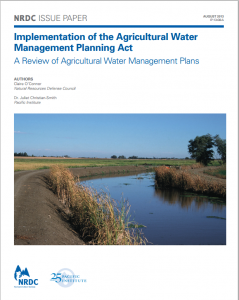Implementation of the Agricultural Water Management Planning Act: A Review of Agricultural Water Management Plans

Implementation of the Agricultural Water Management Planning Act: A Review of Agricultural Water Management Plans
Seventy Percent of Legally Required Agricultural Water Management Plans Not Submitted Twenty-four of California’s agricultural water districts have submitted agricultural water management plans, leaving 55 districts out of compliance with the requirement of the Water Conservation Act of 2009, according to a new joint analysis issued today by the Natural Resources Defense Council and the Pacific Institute. This represents a 30% compliance rate, meaning there is much work to be done to ensure sustainable water management for the state. “California is a dry state, expected to only get drier, yet we’re also the leading agricultural state in the nation,” said Claire O’Connor, agricultural water specialist for NRDC. “It’s critical that agricultural water suppliers lead the way in planning for a drier future and encourage customers to be smarter about their water use.” Implementation of the Agricultural Water Management Planning Act: A Review of Agricultural Water Management Plans offers recommendations for those 55 water districts to participate in and comply with future legally required planning cycles, including: 1) California’s Department of Water Resources (DWR) should offer peer-to-peer workshops to assist districts with the planning process; 2) DWR should create an online clearinghouse of plans and draft plans to facilitate public comment; and 3) DWR should hold non-compliant districts accountable, and, per the Act’s mandate, refuse to consider grant and loan requests until districts submit a plan. “When water suppliers prepare plans, the public and other stakeholders can participate in important decisions, like how water efficiency measures should be implemented,” said Juliet Christian-Smith, senior research associate at the Pacific Institute. “Fortunately, we do have some good actors who are leading the way – they are setting the standard for other water districts to follow.” For example, the analysis highlights exemplary plans and activities, such as: At the end of 2009, the California Senate passed a slate of water-related bills designed to improve water efficiency across the state. The Water Conservation Act of 2009 (SB X7-7) applies to water suppliers with at least 25,000 irrigated acres and required agricultural water suppliers to submit an agricultural water management plan by the end of 2012.
Overview
Resources

